2013 SSANGYONG KORANDO change time
[x] Cancel search: change timePage 929 of 1336

7810-00
3) Fluidic Washer Nozzle
This vehicle has the fluidic washer nozzle, which is designed to use fluid movement occurring in the
washer fluid spraying process.
When installing the washer nozzle, make sure that the mounting surface is clean and free of dirt or
debris, since the water may come into the engine compartment in accordance with a seamless
contact condition between the mounting surface of the nozzle and the curved surface of the engine
hood. *
The inside of the nozzle is designed in a fan shape to change the spray direction continuously based on
the time the fluid is sprayed. Refer to the figure below.
The spray direction is changed by means of the whirlwind and back flow generated while the washer
fluid is passing through the nozzle.Washer fluid inlet portSpray passage Counter-currentPassageWasher fluid outlet port
Whirlwind
Washer nozzle
Page 976 of 1336
![SSANGYONG KORANDO 2013 Service Manual Press the [4INT] button repeatedly to select the intro play mode.
- INT: Play the intro of all the songs in the current folder in order for about 10 seconds (applies
only to MP3/WMA disc)
- IN SSANGYONG KORANDO 2013 Service Manual Press the [4INT] button repeatedly to select the intro play mode.
- INT: Play the intro of all the songs in the current folder in order for about 10 seconds (applies
only to MP3/WMA disc)
- IN](/manual-img/67/57503/w960_57503-975.png)
Press the [4INT] button repeatedly to select the intro play mode.
- INT: Play the intro of all the songs in the current folder in order for about 10 seconds (applies
only to MP3/WMA disc)
- INT: Play the intro of all the song in the disc in order for about 10 seconds
- OFF: Deactivates playing intro 2.To change play mode
Press the [2RPT] button repeatedly to select the repeat mode.
- RPT: Repeat all the songs in the current folder in order (applies only to MP3/WMA disc)
- RPT: Repeat the playing song consecutively
- OFF: Deactivates repeat mode 1.
Search for song and play it
When [MENU] button is pressed after turning the [TUNE] dial to select the song number or name to
play, the system begins playing the song. 1.
MP3[WMA] song information view
If you press the [INF] button briefly and repeatedly when a song is playing, other information
(artist/album/genre/play time) for the song is displayed for 3 seconds.
If you press and hold the [INF] button when a song is playing, the data table for the song is displayed
for 5 seconds. 1.
2.
To set scroll function
When pressing the [SET] button, "Setup List" is displayed.
Turn the [TUNE] dial to select the desired "Scroll On/Off" and press the [ENTER] button to select ON
or OFF. 1.
2.Press the [5RDM] button repeatedly to select the random play mode.
- RDM: Play all the songs in the current folder in random order
(applies only to MP3/WMA disc)
- RDM: Play all the song in the disc in random order
- OFF: Deactivates random play mode 3.
8. MP3 [WMA]/CD PLAYER
Page 978 of 1336
![SSANGYONG KORANDO 2013 Service Manual Answering an incoming call
When the call is incoming, the bell rings and "CALL IN" and sender's telephone number are
displayed. -
Hang-up call
To hang-up the call, press the [END] button. SSANGYONG KORANDO 2013 Service Manual Answering an incoming call
When the call is incoming, the bell rings and "CALL IN" and sender's telephone number are
displayed. -
Hang-up call
To hang-up the call, press the [END] button.](/manual-img/67/57503/w960_57503-977.png)
Answering an incoming call
When the call is incoming, the bell rings and "CALL IN" and sender's telephone number are
displayed. -
Hang-up call
To hang-up the call, press the [END] button.
- The call is ended and system returns to the previous screen.
- However, the connection between the audio system and the phone remains "connected". 1.To make a call, press the [Call] button.
- "BT TEL" is displayed during a call and you can converse through the microphone and
speaker connected to this system. If you don't want to receive a call, press the [End] button
to reject it.
- After "CALL REJECT" is displayed, the system returns to the previous screen. 1.
To adjust volume
Turn the [VOL] dial to adjust the volume.
- The adjustable range is between BT VOL 06 to 32. 1.
Mute function
Press the [MUTE] button on the audio remote control to activate the mute function.
- "MIC MUTE" is displayed and the other party can't hear your voice.
- Press the [MUTE] button again to resume your conversation. 1.
Private mode
When you press the [Call] button during hands-free call, "PRIVATE" is displayed and hands-free call
is changed to cellular phone call. When you press the [Call] button during cellular phone call, "BT
TEL" is displayed and cellular phone call is changed to hands-free call.
- This function may not be available on some phone models. 1.You can change to private call using a cellular phone during hands-free call. (The other party's voice
is coming through only the cellular phone, not speaker.) -
To disconnect
Press and hold the [End] button to disconnect the connection with Bluetooth device and press and
hold it once again to turn off the Bluetooth function.
- At this time, "BT DISCONNECT" is displayed and the Bluetooth icon disappears. 1.
Playing music stored in cellular phone
Press the [MEDIA] button repeatedly to select "BT AUDIO".
After playing the music using a music-playback function in the cellular phone, turn the [VOL] dial to
adjust the volume.
To exit the function, press the [End] button or press the [BAND/AS], [MEDIA] or CD button to select
other function. 1.
2.
3.
Page 1066 of 1336
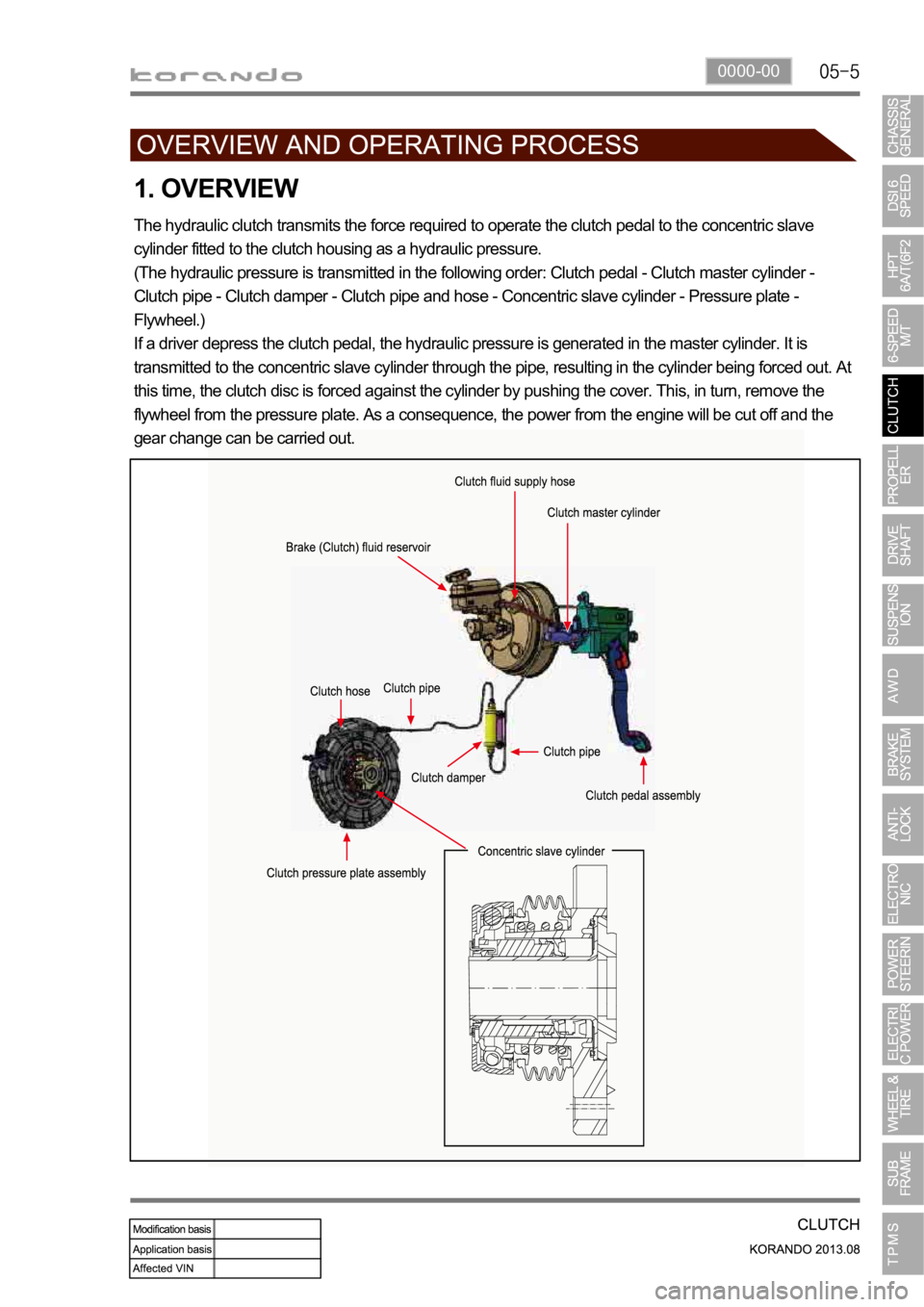
0000-00
1. OVERVIEW
The hydraulic clutch transmits the force required to operate the clutch pedal to the concentric slave
cylinder fitted to the clutch housing as a hydraulic pressure.
(The hydraulic pressure is transmitted in the following order: Clutch pedal - Clutch master cylinder -
Clutch pipe - Clutch damper - Clutch pipe and hose - Concentric slave cylinder - Pressure plate -
Flywheel.)
If a driver depress the clutch pedal, the hydraulic pressure is generated in the master cylinder. It is
transmitted to the concentric slave cylinder through the pipe, resulting in the cylinder being forced out. At
this time, the clutch disc is forced against the cylinder by pushing the cover. This, in turn, remove the
flywheel from the pressure plate. As a consequence, the power from the engine will be cut off and the
gear change can be carried out.
Page 1124 of 1336
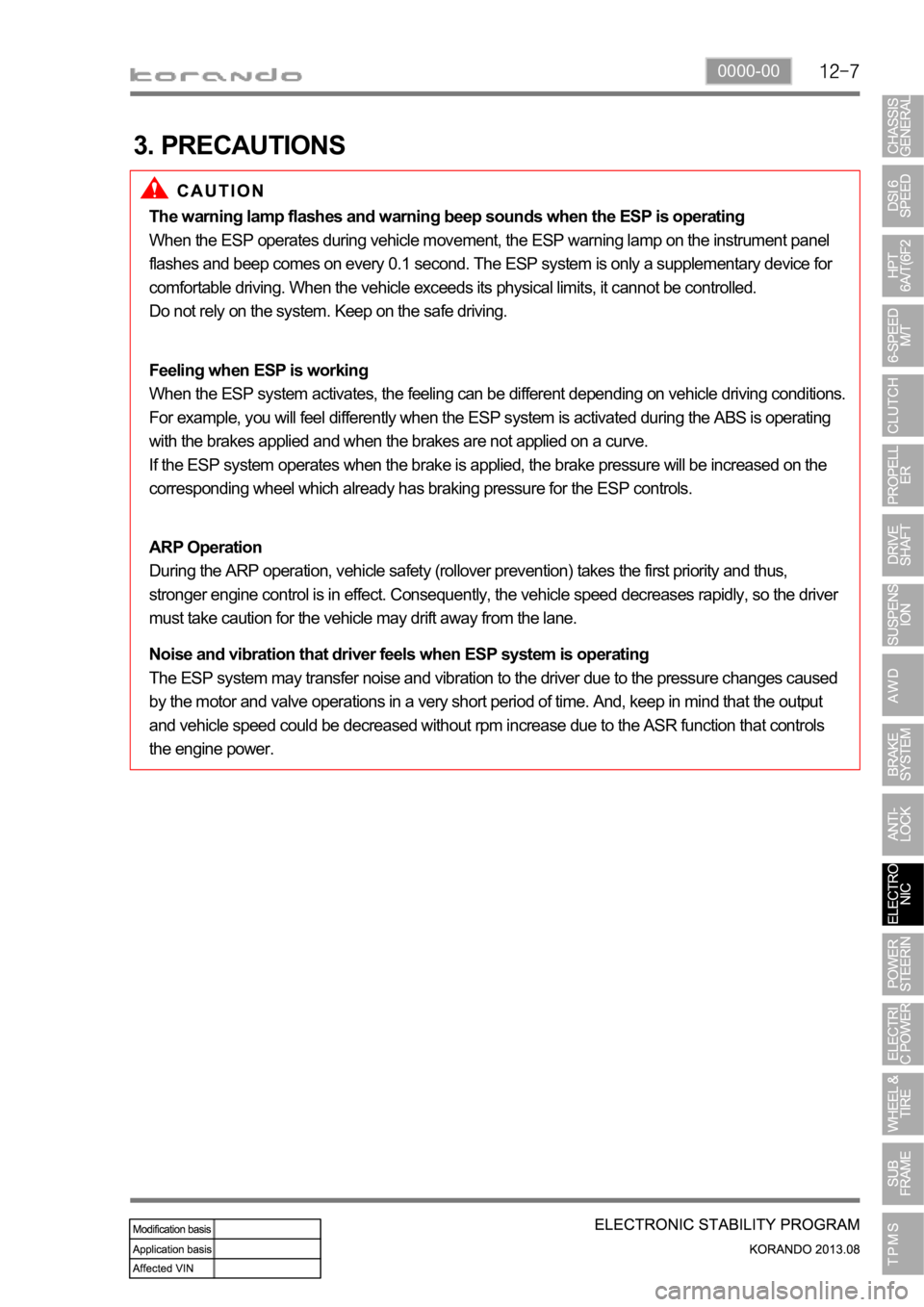
0000-00
3. PRECAUTIONS
The warning lamp flashes and warning beep sounds when the ESP is operating
When the ESP operates during vehicle movement, the ESP warning lamp on the instrument panel
flashes and beep comes on every 0.1 second. The ESP system is only a supplementary device for
comfortable driving. When the vehicle exceeds its physical limits, it cannot be controlled.
Do not rely on the system. Keep on the safe driving.
Feeling when ESP is working
When the ESP system activates, the feeling can be different depending on vehicle driving conditions.
For example, you will feel differently when the ESP system is activated during the ABS is operating
with the brakes applied and when the brakes are not applied on a curve.
If the ESP system operates when the brake is applied, the brake pressure will be increased on the
corresponding wheel which already has braking pressure for the ESP controls.
ARP Operation
During the ARP operation, vehicle safety (rollover prevention) takes the first priority and thus,
stronger engine control is in effect. Consequently, the vehicle speed decreases rapidly, so the driver
must take caution for the vehicle may drift away from the lane.
Noise and vibration that driver feels when ESP system is operating
The ESP system may transfer noise and vibration to the driver due to the pressure changes caused
by the motor and valve operations in a very short period of time. And, keep in mind that the output
and vehicle speed could be decreased without rpm increase due to the ASR function that controls
the engine power.
Page 1137 of 1336
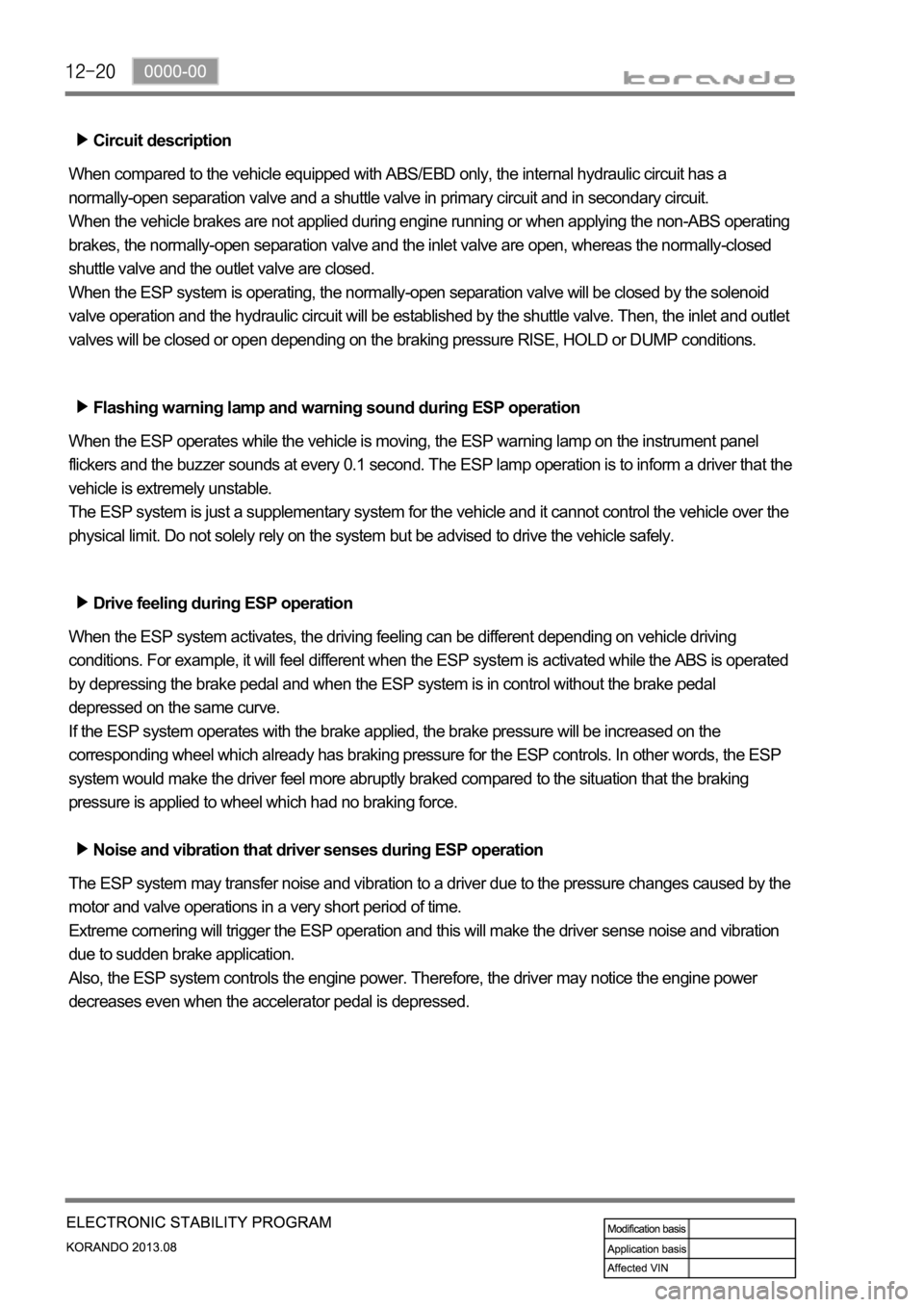
Circuit description
When compared to the vehicle equipped with ABS/EBD only, the internal hydraulic circuit has a
normally-open separation valve and a shuttle valve in primary circuit and in secondary circuit.
When the vehicle brakes are not applied during engine running or when applying the non-ABS operating
brakes, the normally-open separation valve and the inlet valve are open, whereas the normally-closed
shuttle valve and the outlet valve are closed.
When the ESP system is operating, the normally-open separation valve will be closed by the solenoid
valve operation and the hydraulic circuit will be established by the shuttle valve. Then, the inlet and outlet
valves will be closed or open depending on the braking pressure RISE, HOLD or DUMP conditions.
Flashing warning lamp and warning sound during ESP operation
When the ESP operates while the vehicle is moving, the ESP warning lamp on the instrument panel
flickers and the buzzer sounds at every 0.1 second. The ESP lamp operation is to inform a driver that the
vehicle is extremely unstable.
The ESP system is just a supplementary system for the vehicle and it cannot control the vehicle over the
physical limit. Do not solely rely on the system but be advised to drive the vehicle safely.
Drive feeling during ESP operation
When the ESP system activates, the driving feeling can be different depending on vehicle driving
conditions. For example, it will feel different when the ESP system is activated while the ABS is operated
by depressing the brake pedal and when the ESP system is in control without the brake pedal
depressed on the same curve.
If the ESP system operates with the brake applied, the brake pressure will be increased on the
corresponding wheel which already has braking pressure for the ESP controls. In other words, the ESP
system would make the driver feel more abruptly braked compared to the situation that the braking
pressure is applied to wheel which had no braking force.
Noise and vibration that driver senses during ESP operation
The ESP system may transfer noise and vibration to a driver due to the pressure changes caused by the
motor and valve operations in a very short period of time.
Extreme cornering will trigger the ESP operation and this will make the driver sense noise and vibration
due to sudden brake application.
Also, the ESP system controls the engine power. Therefore, the driver may notice the engine power
decreases even when the accelerator pedal is depressed.
Page 1158 of 1336
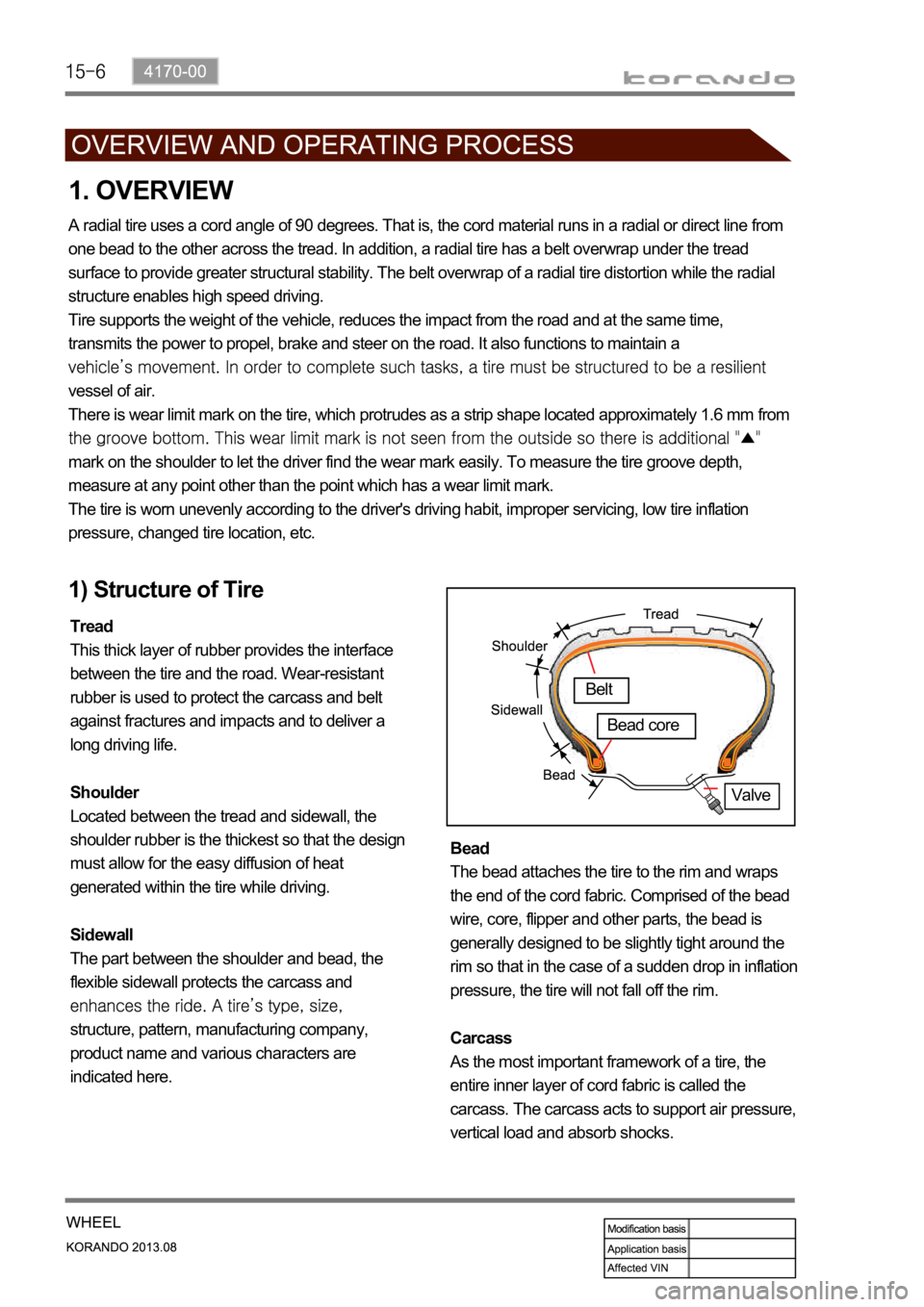
1. OVERVIEW
A radial tire uses a cord angle of 90 degrees. That is, the cord material runs in a radial or direct line from
one bead to the other across the tread. In addition, a radial tire has a belt overwrap under the tread
surface to provide greater structural stability. The belt overwrap of a radial tire distortion while the radial
structure enables high speed driving.
Tire supports the weight of the vehicle, reduces the impact from the road and at the same time,
transmits the power to propel, brake and steer on the road. It also functions to maintain a
vessel of air.
There is wear limit mark on the tire, which protrudes as a strip shape located approximately 1.6 mm from
mark on the shoulder to let the driver find the wear mark easily. To measure the tire groove depth,
measure at any point other than the point which has a wear limit mark.
The tire is worn unevenly according to the driver's driving habit, improper servicing, low tire inflation
pressure, changed tire location, etc.
1) Structure of Tire
Tread
This thick layer of rubber provides the interface
between the tire and the road. Wear-resistant
rubber is used to protect the carcass and belt
against fractures and impacts and to deliver a
long driving life.
Shoulder
Located between the tread and sidewall, the
shoulder rubber is the thickest so that the design
must allow for the easy diffusion of heat
generated within the tire while driving.
Sidewall
The part between the shoulder and bead, the
flexible sidewall protects the carcass and
structure, pattern, manufacturing company,
product name and various characters are
indicated here. Bead
The bead attaches the tire to the rim and wraps
the end of the cord fabric. Comprised of the bead
wire, core, flipper and other parts, the bead is
generally designed to be slightly tight around the
rim so that in the case of a sudden drop in inflation
pressure, the tire will not fall off the rim.
Carcass
As the most important framework of a tire, the
entire inner layer of cord fabric is called the
carcass. The carcass acts to support air pressure,
vertical load and absorb shocks.
Valve
Belt
Bead core
Page 1179 of 1336
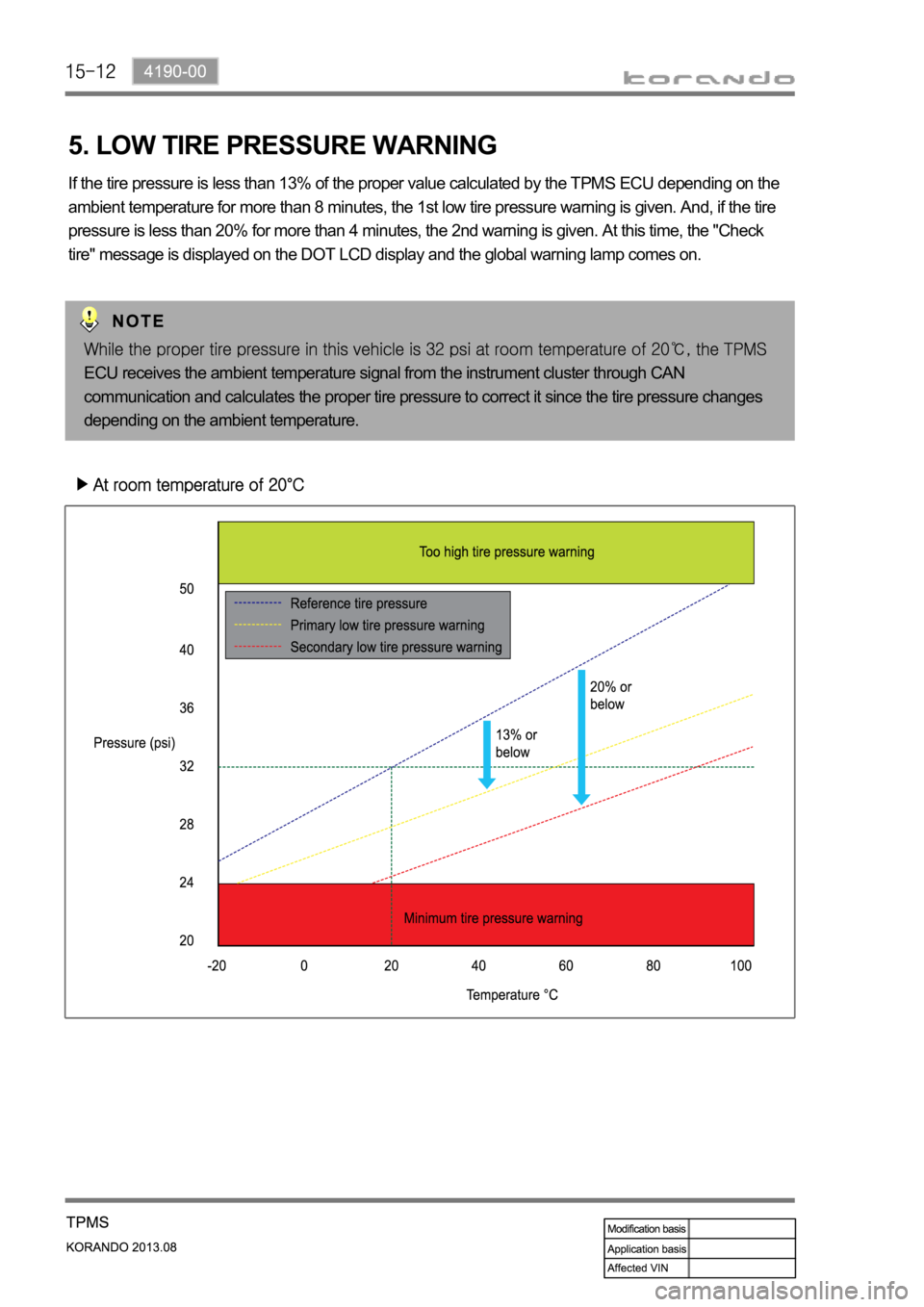
5. LOW TIRE PRESSURE WARNING
If the tire pressure is less than 13% of the proper value calculated by the TPMS ECU depending on the
ambient temperature for more than 8 minutes, the 1st low tire pressure warning is given. And, if the tire
pressure is less than 20% for more than 4 minutes, the 2nd warning is given. At this time, the "Check
tire" message is displayed on the DOT LCD display and the global warning lamp comes on.
ECU receives the ambient temperature signal from the instrument cluster through CAN
communication and calculates the proper tire pressure to correct it since the tire pressure changes
depending on the ambient temperature.